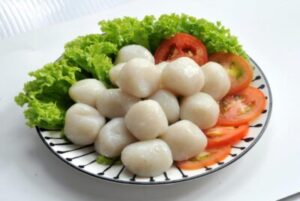 Fish balls stand as a popular and delightful delicacy loved by seafood enthusiasts. One of the secret ingredients behind their delectable taste and exceptional texture is Na5P3O10(Sodium Tripolyphosphate). In this blog, we will uncover how Na5P3O10(Sodium Tripolyphosphate) enhances fish balls, taking them to new heights of flavor and succulence.
Fish balls stand as a popular and delightful delicacy loved by seafood enthusiasts. One of the secret ingredients behind their delectable taste and exceptional texture is Na5P3O10(Sodium Tripolyphosphate). In this blog, we will uncover how Na5P3O10(Sodium Tripolyphosphate) enhances fish balls, taking them to new heights of flavor and succulence.
What is Na5P3O10(Sodium Tripolyphosphate)?
Na5P3O10(Sodium Tripolyphosphate), commonly referred to as STPP, is an inorganic compound derived from phosphate salts. It appears as a white powder with exceptional water solubility. Due to its versatility, STPP is widely used in various industries, especially in the food processing industry.
What Na5P3O10(Sodium Tripolyphosphate) Do in Fish Balls?
Na5P3O10(Sodium Tripolyphosphate) (STPP) plays a critical role in the creation of fish balls, impacting their texture, moisture retention, and overall mouthfeel. As a food additive, STPP exhibits various functionalities that make it a prized asset in the culinary world.
Texture Enhancement and Moisture Retention
The texture of fish balls is one of the defining factors that discerns a great dish from an exceptional one. Na5P3O10(Sodium Tripolyphosphate) aids in improving the texture of fish balls by increasing the water-holding capacity of proteins. This results in fish balls that are plump, tender, and juicy, inviting an explosion of flavors with every bite.
Binding Properties for Cohesion
A key challenge in creating fish balls is achieving the perfect cohesion of ingredients. Na5P3O10(Sodium Tripolyphosphate) excels in its binding properties, ensuring that the fish paste and other components amalgamate seamlessly, forming uniform and well-structured fish balls.
Emulsification for Consistency
Emulsification is crucial in fish ball preparation to create a smooth and consistent mixture. Na5P3O10(Sodium Tripolyphosphate)’s emulsifying properties help stabilize oil and water-based components, preventing separation during the cooking process and preserving the integrity of the fish balls.
Preserving Freshness and Color
Fish balls often undergo various cooking processes, which may impact their color and freshness. Here, Na5P3O10(Sodium Tripolyphosphate) proves its worth as a preservative, effectively binding and stabilizing metal ions that promote oxidation. This preservation ensures that the natural colors and flavors of the fish balls are retained, making them visually appealing and mouthwateringly appetizing.
Uniform Cooking and Reduced Cooking Loss
When cooking fish balls, Na5P3O10(Sodium Tripolyphosphate) aids in promoting even heat distribution, resulting in uniform cooking. Moreover, it reduces cooking loss, preventing the fish balls from becoming dry and flavorless.
Minimized Crumbling and Breakage
Fish balls are delicate creations, and maintaining their structural integrity is crucial to their presentation and enjoyment. Na5P3O10(Sodium Tripolyphosphate) plays a pivotal role in minimizing crumbling and breakage during handling and cooking. Its binding properties hold the fish ball mixture together, ensuring that the end product remains intact and visually appealing.
Consistency in Large-Scale Production
For manufacturers producing fish balls in large quantities, maintaining consistency is essential to meet customer expectations. Na5P3O10(Sodium Tripolyphosphate) assists in achieving uniformity in texture, taste, and appearance across batches, ensuring that every fish ball is a delightful culinary delight.
What Else Should Be Taken Care of When Applying Na5P3O10(Sodium Tripolyphosphate)?
Proper Measurement
As a general guideline, the recommended dosage of Na5P3O10(Sodium Tripolyphosphate) in fish balls is about 0.5% to 1.0% of the weight of the fish meat used. For instance, if you’re using 1 kilogram of fish meat, you would add 5 to 10 grams of STPP. To ensure accuracy, use a food-grade digital scale that can provide precise measurements. Always remember that less is more when it comes to using food additives like Na5P3O10(Sodium Tripolyphosphate).
Soaking Time
After you’ve mixed Na5P3O10(Sodium Tripolyphosphate) with water to make a diluted solution, soak the fish meat in it for around 30 minutes to an hour. The soaking time can vary depending on the type and size of the fish pieces, and your desired texture outcome. Always make sure to rinse the fish thoroughly after soaking to remove any excess Na5P3O10(Sodium Tripolyphosphate).
In conclusion, Na5P3O10(Sodium Tripolyphosphate) stands as an exceptional ingredient that breathes life into seafood balls and seafood paste. Its multifaceted properties, from preserving freshness and elevating texture to safeguarding natural flavors, make it an invaluable asset in the culinary world. For quotation, please reach out to [email protected], we’re pleased to serve you.




